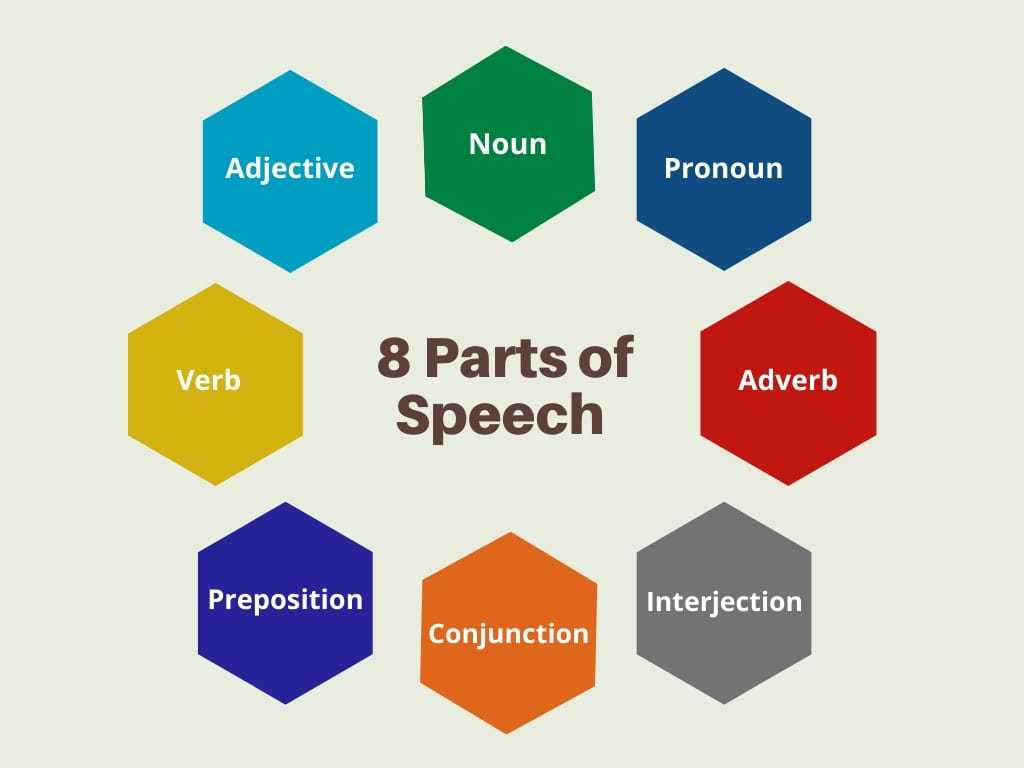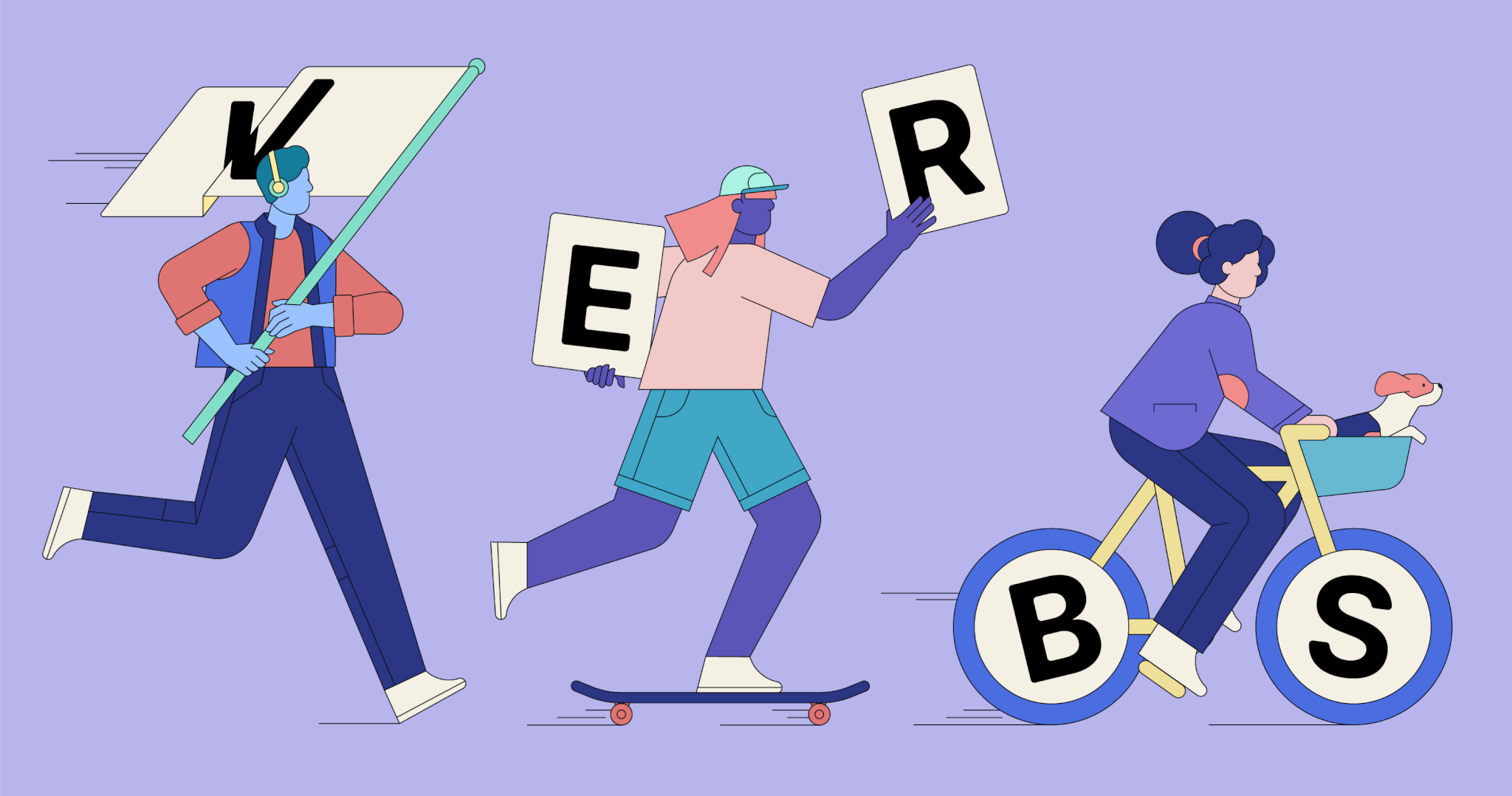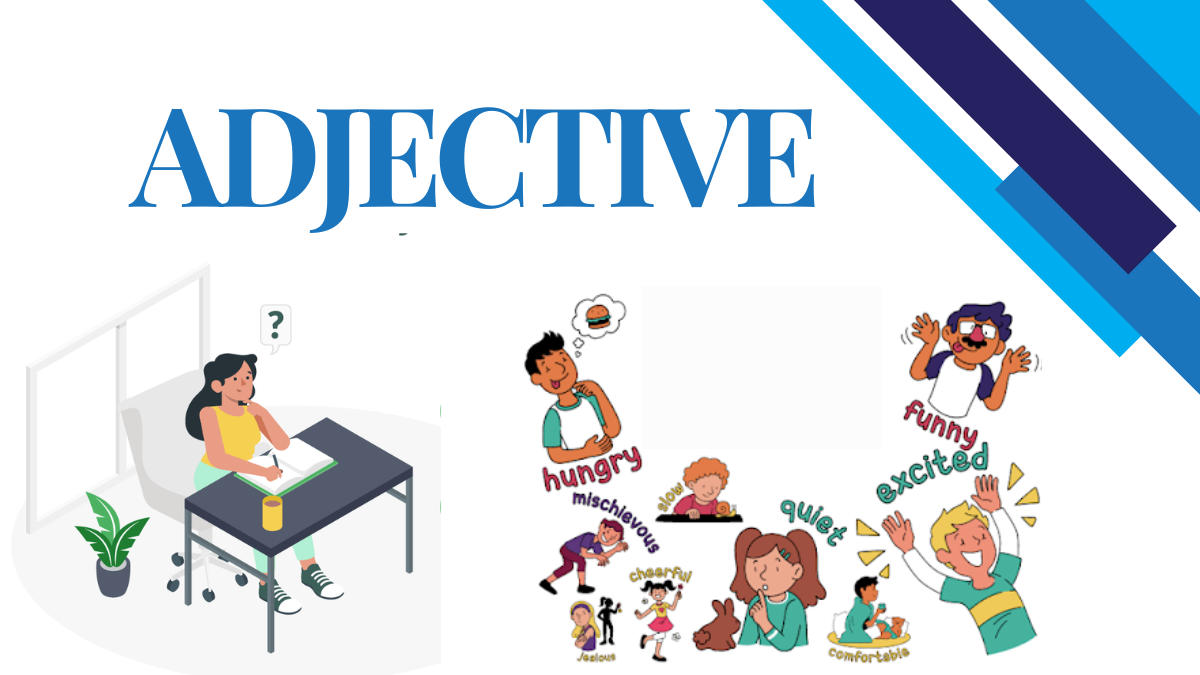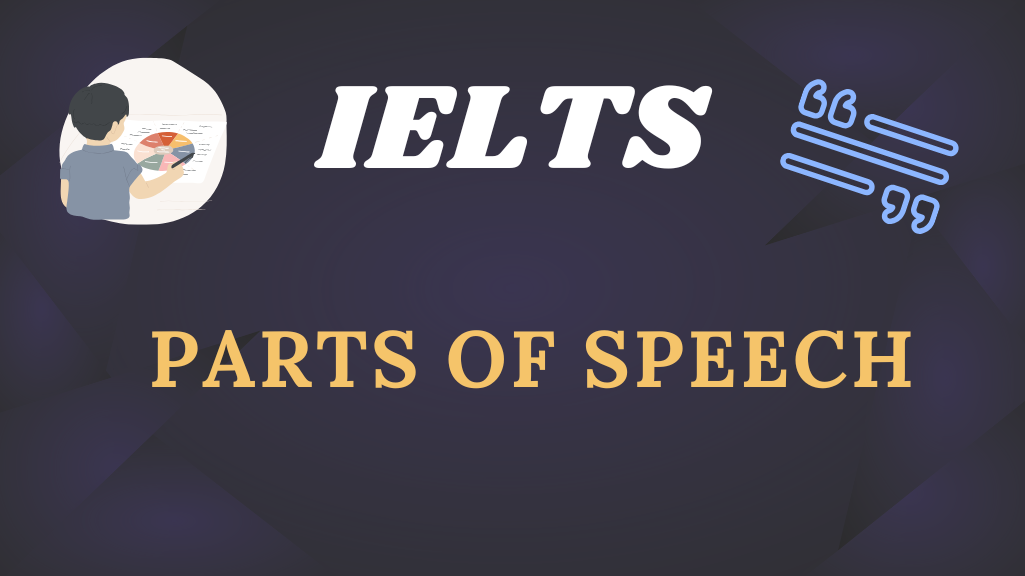In English, every word belongs to a part of speech, which determines its function in a sentence. For IELTS Writing, Speaking, Reading, and Listening, understanding these categories can enhance your clarity, coherence, and grammatical accuracy.
This guide will explain each part of speech in depth, highlight exceptions, and provide usage tips to help you score better in IELTS.

The Eight Parts of Speech
Ever wondered how words work together to make sentences? Well, every word has a job, and these jobs fall into eight categories: nouns, pronouns, verbs, adjectives, adverbs, prepositions, conjunctions, and interjections. Some words name things, some describe, others show action, and a few even express emotions. Knowing these parts of speech makes writing and speaking way easier. Here’s a quick breakdown:
| Part of Speech | What It Does | Examples |
|---|---|---|
| Noun | Names a person, place, thing, or idea | dog, New York, happiness |
| Pronoun | Replaces a noun to avoid repetition | he, she, they, it |
| Verb | Shows action or a state of being | run, jump, is |
| Adjective | Describes or modifies a noun | happy, blue, tall |
| Adverb | Modifies a verb, adjective, or another adverb | quickly, very, well |
| Preposition | Connects nouns to the rest of the sentence | on, in, under |
| Conjunction | Joins words, phrases, or clauses | and, but, because |
| Interjection | Expresses emotion or excitement | Wow! Oh! Ouch! |
Nouns
A noun is a word that represents a person, place, thing, idea, or concept. It is one of the main parts of speech in English grammar. Nouns can be subjects or objects in a sentence and are often the main focus of what is being talked about.
Examples:
- People: student, doctor, Emma
- Places: city, university, park
- Things: book, phone, table
- Ideas: happiness, democracy, freedom

Types of Nouns
| Type | Definition | Examples |
|---|---|---|
| Common Noun | General names | school, teacher, country |
| Proper Noun | Specific names (always capitalized) | London, Shakespeare, NASA |
| Countable Noun | Can be counted | book, apple, car |
| Uncountable Noun | Cannot be counted | water, rice, happiness |
| Abstract Noun | Ideas or qualities | love, wisdom, strength |
| Concrete Noun | Physical objects | table, phone, cat |
| Collective Noun | Group of things or people | team, family, audience |
Exceptions & Irregularities in Nouns
1. Some nouns can be both countable and uncountable:
"Paper" (uncountable: "I need some paper.")
"A paper" (countable: "I wrote a paper on climate change.")
2. Some nouns have the same singular and plural form:
Sheep, deer, aircraft, species
Example: "One sheep is in the field." / "Many sheep are grazing."
3. Plural nouns that don't end in 's':
Child → Children
Man → Men
Mouse → Mice
IELTS Tip:
Using nouns with quantifiers in IELTS Writing Task 1 (Academic) is a great way to show your ability to present data clearly and accurately.
✔ "The number of students increased in 2023." ✔ "There was a significant rise in the population of the city over the last decade." ✔ "The amount of rainfall declined in the region during the summer months."
In these examples, quantifiers like number, amount, and rise help describe changes in data. Quantifiers can make your writing sound more precise and formal, which is key for academic writing.
Pronouns
A pronoun is a word that takes the place of a noun in a sentence. Pronouns are used to avoid repetition and make sentences clearer and smoother. They refer to people, things, or ideas that have already been mentioned or are easily understood from context.
Types of Pronouns & Examples
| Type | Example |
|---|---|
| Personal Pronoun | I, you, he, she, it, we, they |
| Possessive Pronoun | mine, yours, his, hers, ours, theirs |
| Demonstrative Pronoun | this, that, these, those |
| Relative Pronoun | who, which, that, whose, whom |
| Interrogative Pronoun | who, what, which, whose, whom |
| Indefinite Pronoun | some, any, nobody, everything |
| Reflexive Pronoun | myself, yourself, himself, herself |
Exceptions & Common Mistakes
"It" vs. "They" for non-human subjects
Incorrect: "The government announced their decision."
Correct: "The government announced its decision."
"Who" vs. "Whom"
Who (subject): "Who is calling?"
Whom (object): "Whom did you call?"
Verbs
A verb is a word that expresses an action, occurrence, or state of being. Verbs are one of the core components of a sentence, as they tell what the subject is doing or what is happening.
Types of Verbs
| Type of Verb | Description | Examples | Example Sentence |
|---|---|---|---|
| Action Verbs | Express physical or mental actions | run, jump, think, eat, write, swim | She runs every morning. |
| Linking Verbs | Connect the subject to a complement or description | am, is, are, was, were, seem, become | He is tired. |
| Helping Verbs | Work with the main verb to express tense, mood, or voice | be, have, do, can, could, will, would | She has finished her homework. |
| Modal Verbs | Express necessity, possibility, permission, or ability | can, could, may, might, should, would | You should study for the exam. |
| Transitive Verbs | Require a direct object to complete their meaning | eat (something), write (a letter), give (a gift) | She bought a new phone. |
| Intransitive Verbs | Do not require a direct object | sleep, arrive, sit, go | He arrived early. |

Exceptions & Irregularities in Verbs
1. Irregular Verbs
Irregular verbs do not follow the typical pattern of adding -ed to form the past tense or past participle. Instead, their forms change in unpredictable ways. Here's a table to highlight some common irregular verbs:
| Base Form | Past Tense | Past Participle |
|---|---|---|
| go | went | gone |
| eat | ate | eaten |
| take | took | taken |
| have | had | had |
| be | was/were | been |
| see | saw | seen |
| come | came | come |
| give | gave | given |
| do | did | done |
| get | got | gotten/got |
2. Irregular Forms of Verbs
Some verbs have irregularities in their forms but are only irregular in certain tenses.
"Have": The verb “have” is often irregular, with "had" as the past tense and past participle. For example:
Present: I have a book.
Past: I had a book yesterday.
"Be": The verb "be" is irregular in its forms:
Present: I am (singular), we are (plural).
Past: I was (singular), we were (plural).
3. Phrasal Verbs
Some verbs change meaning when combined with prepositions or adverbs. These combinations are called phrasal verbs, and they often have irregular forms.
Example: "Break down" (stop working) vs. "Break up" (end a relationship).
"She broke down in tears."
"They broke up after two years."
4. Modal Verbs
Modal verbs, such as can, may, must, should, could, do not follow the typical verb conjugation rules. They don’t change form for different subjects (e.g., "he can", "they can") and don't have a past participle.
Example of exception:
"She can swim."
"He could swim when he was young."
5. Spelling Changes in Regular Verbs
While most verbs follow the regular pattern of adding -ed for the past tense, some regular verbs have spelling changes:
Verbs ending in "e": Simply add -d instead of -ed.
"Love" becomes "loved."
Verbs ending in consonant + "y": Drop the "y" and add -ied.
"Cry" becomes "cried."
Verbs with a single vowel + consonant: Double the final consonant and add -ed.
"Hop" becomes "hopped."
6. Exceptions to Regularity
Some regular verbs have minor irregularities, like "read", which is spelled the same in the present and past, but pronounced differently:
Present: "I read a book every day." (pronounced "reed")
Past: "I read a book yesterday." (pronounced "red")
Use modal verbs in Writing Task 2: "Governments should invest in education."
Adjectives
Adjectives are words that describe or modify nouns, giving more detail about the person, thing, or idea the noun represents. They can describe qualities, quantities, or states, and they help make language more vivid and specific.

Types of Adjectives
| Type | Example |
|---|---|
| Quality | beautiful, intelligent, exciting |
| Size | small, huge, tall |
| Color | red, blue, green |
| Number | three, many, few |
Exceptions & Irregularities
Order of Adjectives:
- "A beautiful small red car" (✓ Correct)
- "A red small beautiful car" (✗ Incorrect)
- Order: Quantity/Number→opinion → Size → Age → Shape → Color → Origin → Material → Purpose
Comparative and Superlative Forms:
Positive Degree:
Just the basic form of the adjective (e.g., "big").
The house is big.
Comparative Degree:
Used to compare two things (e.g., "bigger").
The house is bigger than the apartment.
Superlative Degree:
Used to show the highest degree among three or more things (e.g., "biggest").
The house is the biggest in the neighborhood.
Adverbs
An adverb describes how, when, where, or to what extent something happens.
Types of Adverbs & Examples
| Type of Adverb | Description | Examples | Example Sentence |
|---|---|---|---|
| Adverbs of Manner | Describes how an action is done. | slowly, quickly, carefully, loudly, easily | She sings beautifully. |
| Adverbs of Time | Tells us when something happens or the frequency of an action. | today, tomorrow, always, never, soon, already | I will call you tomorrow. |
| Adverbs of Place | Indicates where an action takes place. | here, there, everywhere, nowhere, inside | She looked everywhere for her keys. |
| Adverbs of Frequency | Expresses how often an action occurs. | always, usually, often, sometimes, rarely | He rarely eats vegetables. |
| Adverbs of Degree | Tells us the extent or intensity of an action, adjective, or another adverb. | very, quite, almost, too, extremely | The movie was extremely exciting. |
| Adverbs of Probability | Indicates how likely something is to happen. | probably, certainly, perhaps, surely, maybe | She will probably come to the party. |
| Interrogative Adverbs | Used to ask questions related to time, place, manner, or reason. | when, where, how, why | Why did you leave so early? |
Exceptions & Common Mistakes
Not all adverbs end in "-ly":
Fast (adjective) → Fast (adverb)
Hard (adjective) → Hard (adverb)
Adverb placement matters:
"He speaks English fluently." (✓ Correct)
"He fluently speaks English." (✓ Correct, but less natural in IELTS Speaking)
Prepositions
Prepositions are words that show the relationship between a noun (or pronoun) and other words in a sentence. They typically express relationships involving time, place, direction, cause, manner, and other abstract connections. Prepositions often link nouns or pronouns to verbs, adjectives, or other nouns to provide more detail in the sentence.

Examples:
- Time: in, on, at → "I was born in May."
- Place: at, in, on → "The book is on the table."
| Type of Preposition | Description | Examples | Example Sentence |
|---|---|---|---|
| Prepositions of Time | Shows the relationship of a noun with time. | at, on, in, during, before, after | We will meet at 5 PM. |
| Prepositions of Place | Indicates the location of something. | at, in, on, under, between, beside, next to, above | The book is on the table. |
| Prepositions of Direction | Shows the direction or movement of something. | to, from, into, onto, through, across | She walked to the park. |
| Prepositions of Cause | Expresses the reason or cause for something. | because of, due to, owing to, on account of | He was absent because of illness. |
| Prepositions of Manner | Describes how an action is performed. | by, with, like, as | He traveled by car. |
| Prepositions of Agent | Used to show who or what performs an action. | by | The book was written by J.K. Rowling. |
| Prepositions of Instrument | Shows the tool or means used to perform an action. | with, by | She cut the paper with scissors. |
| Prepositions of Time/Duration | Indicates the duration or length of an event. | for, since, during, by | He stayed for two weeks. |
| Prepositions of Comparison | Compares one thing with another. | than, as, like | She is taller than her brother. |
| Prepositions of Purpose | Expresses the reason or purpose for an action. | for, to | This tool is used for cutting. |
Conjunctions
Conjunctions are words that connect words, phrases, clauses, or sentences. They help in linking ideas and showing relationships between them, allowing for smoother and more complex sentence structures.
Types of Conjunctions
1. Coordinating Conjunctions
- These conjunctions join elements of equal importance, like words, phrases, or independent clauses.
- Examples: and, but, or, nor, for, so, yet
| Conjunction | Example | Example Sentence |
|---|---|---|
| and | He likes ice cream and cake. | She wants to go swimming and hiking. |
| but | She is tall but not very strong. | I wanted to go, but I was too tired. |
| or | Do you want tea or coffee? | You can either take the bus or walk. |
| nor | She does not like tea, nor coffee. | He doesn’t play soccer, nor does he like it. |
| for | She was late, for she missed the bus. | I stayed home, for it was raining. |
| so | I was tired, so I went to bed. | He studied hard, so he passed the test. |
| yet | It’s raining, yet they went outside. | She is smart, yet she struggles with writing. |
2. Subordinating Conjunctions
- These conjunctions connect an independent clause with a dependent (subordinate) clause. They show the relationship between the two clauses.
- Examples: although, because, since, unless, while, if, when, after, before, as, though, even though, until, as if
| Conjunction | Example | Example Sentence |
|---|---|---|
| although | Although it was raining, we went outside. | I will go although I am tired. |
| because | I stayed home because I was sick. | He was happy because he passed the exam. |
| if | If it rains, we will stay inside. | I will help if you need me. |
| unless | You will fail unless you study hard. | I will go unless it is too late. |
| while | She was reading while he was cooking. | I’ll wait here while you finish your homework. |
| after | We left after the show ended. | After the storm, the sky cleared up. |
| before | He always stretches before running. | Wash your hands before eating. |
| since | He has been acting strangely since the event. | I haven’t seen her since last summer. |
| even though | Even though it’s late, I’ll call her. | He is happy, even though he is sick. |
| as if | She talks as if she knows everything. | He looks as if he hasn’t slept for days. |
3. Correlative Conjunctions
- These conjunctions come in pairs and connect equal sentence elements. They must work together in a sentence.
- Examples: either...or, neither...nor, not only...but also, both...and, whether...or, such...that, as...as
| Conjunction | Example | Example Sentence |
|---|---|---|
| either...or | You can either take the bus or walk. | Either you go now, or you stay and wait. |
| neither...nor | Neither the cat nor the dog is here. | Neither my mother nor my father is home. |
| not only...but also | He is not only a teacher, but also a coach. | Not only is she beautiful, but also talented. |
| both...and | Both the teacher and the students were present. | Both the car and the bike need repairs. |
| whether...or | I don’t know whether to go or stay. | Whether you like it or not, we have to leave. |
| such...that | The movie was such a hit that it broke records. | It was such a nice day that we stayed outside. |
| as...as | She is as tall as her brother. | This puzzle is as difficult as the last one. |
Interjections
Interjections are words or phrases that express strong emotions or sudden feelings. They are often followed by an exclamation mark and stand alone in a sentence. Interjections add emotion, surprise, excitement, or emphasis to a sentence, but they don't affect the grammatical structure.

Types of Interjections
Expressing Surprise or Shock
- Wow! – "Wow! That was an amazing performance!"
- Oh! – "Oh! I didn't see you there."
- Ah! – "Ah! That makes so much sense now."
- Oh my gosh! – "Oh my gosh! Look at that view!"
- Oh no! – "Oh no! I forgot my keys."
Expressing Joy or Excitement
- Hooray! – "Hooray! We won the game!"
- Yay! – "Yay! I finally finished the project!"
- Whee! – "Whee! This rollercoaster is so much fun!"
- Yippee! – "Yippee! It’s my birthday today!"
Expressing Disappointment or Regret
- Oops! – "Oops! I dropped the plate."
- Alas! – "Alas! It was too late to fix it."
- Oh dear! – "Oh dear! That doesn’t look good."
- Bummer! – "Bummer! We missed the concert."
Expressing Pain or Discomfort
- Ouch! – "Ouch! That really hurt."
- Ow! – "Ow! I stubbed my toe."
- Ugh! – "Ugh! This is so uncomfortable."
Expressing Approval or Agreement
- Yeah! – "Yeah! I totally agree with you."
- Uh-huh! – "Uh-huh! I understand."
- Yep! – "Yep! That sounds great."
Expressing Doubt or Hesitation
- Hmm... – "Hmm... I'm not sure about that."
- Uh... – "Uh... I think I forgot your name."
- Er... – "Er... could you repeat that?"
Expressing Anger or Frustration
- Ugh! – "Ugh! I can’t believe this is happening."
- Bah! – "Bah! This is so annoying!"
- Geez! – "Geez! You scared me there."
Expressing Wonder or Awe
- Wow! – "Wow! That’s incredible!"
- Gosh! – "Gosh! Look at those clouds!"
- Good grief! – "Good grief! What’s going on here?"
